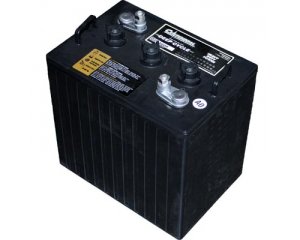With any older RV, I expected that a battery replacement would be necessary sooner rather than later. At the time I purchased my motorhome, the house batteries were garbage. The would provide a little juice (tiny little) but not much.
 Wouldn’t it be great if batteries lasted forever?!?!
Wouldn’t it be great if batteries lasted forever?!?!
I had hoped that I could revive them and get a few months of service. I tried charging under various forms and desulfating them. Nothing helped. Voltage in both batteries was extremely low clearly indicating dead cells. Battery replacement was the only option.
I suppose it is standard for the 1994 Pace Arrow but mine has two battery trays on the front of the vehicle frame for the house batteries (plus one tray for the engine battery). This house battery (or battery bank) provides the power for everything except the engine. Mine had two 12 volt deep cycle batteries (as I said, toast). Deep cycle batteries are not the ideal type of battery for this use. Some will argue. I just refer them to the details on the Internet. The best option is multiple six volt ‘golf cart’ style batteries. These batteries are tailored to the type of use experienced in a motorhome.
I did a lot of searching. The word on the various RV forums was that Sam’s Club had the best price on decent 6 volt batteries. I’m not a member but I talked a friend who is into taking me there. Of course, there were no six volt batteries to be found. Nobody that worked there wanted to help very much but finally did after I proved to be more persistent than they could stand. A minute on the computer revealed that they quit stocking them and they are no longer available. Bummer. I really hate bad news and I really hate inconveniencing my friends.
Back to the Internet for more research.
This quickly turned into one of those deals where I was spending too much time researching and wasting too much gas driving around checking supply. So, I just stopped into Batteries Plus! and bought a couple of batteries. No sale, no coupon.
The new batteries were approximately the same footprint but a little taller. They slipped into place without any problems and the existing hold down clamps even fit.
The previous batteries were 12 volt and wired in parallel (delivering 12 volts). The new 6 volt batteries had to be wired in series to deliver 12 volts. The old cables would not work so a run to the automotive store was required.
An important tip: When performing a battery replacement, always take photos and make sure the cables that are attached to the batteries are marked (positive/negative). We always think that it will just take a moment and we can’t possibly forget, we do OR we get interrupted and don’t get back to the project for hours or days. Being careful here may save you from toasting some other electrical component and experiencing the joy of spending money and time to replace the damage that you caused. Ask me how I know!!
Not on this project though! The hook up went just fine and everything worked as it should – no smoke was released!
I’ve used the new batteries on several boondocking/camping trips and am pleased. Compared to many/most folks, I don’t use a lot of electricity. The biggest consumers of power are a CPAP/BiPAP machine that runs all night, some LED lights, and my laptop computer. Up until now, my coffee pot was 110 volt and I ran the generator to power it. I now have a stove top percolator type coffee pot (Thanks Mike and Jan!) so no need to run the generator. This will make the next trip a fun experiment in energy usage.


Leave a Reply